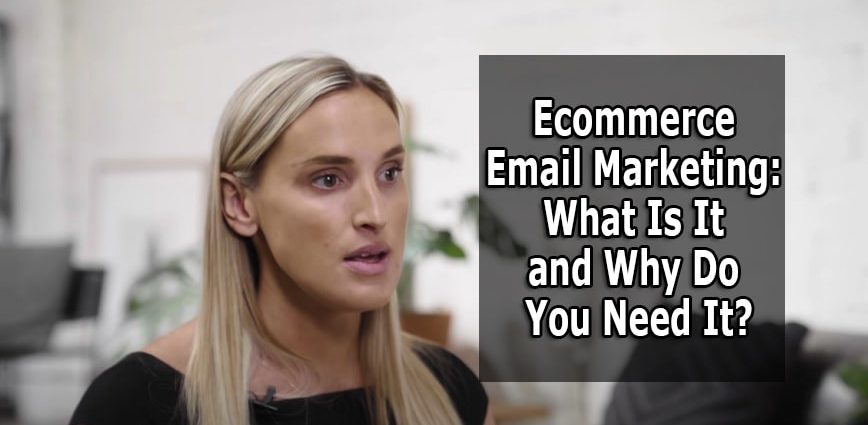Ecommerce email marketing is the practice of advertising an online business (and its items) to subscribers, who may be both prospective and current customers. Shopping cart abandonment emails, promotional emails, and instructional emails are examples of ecommerce email marketing emails.
Even after decades of usage, email remains one of the most dependable means of connecting with people online. It’s also one of the greatest venues to promote your online business. However, what exactly is ecommerce email marketing? Continue reading to learn more!
Your company needs an ecommerce email strategy
When you sell your items on your website through an online shop, you must advertise that business. You must not only make people aware that you are selling, but you must also encourage them to purchase.
There are several ways to advertise your shop on the Internet, but email marketing is one of the most successful. Email has been around for a long time, yet it remains one of the most popular forms of internet communication. This makes it ideal for marketing.
On this page, we’ll address all of your ecommerce email marketing questions, including:
- Just what is ecommerce email marketing?
- Why should you invest in ecommerce email marketing?
- What are the best techniques for developing an ecommerce email marketing strategy?
In addition, make sure you sign up for our weekly newsletter, Revenue Weekly, to get more advice on digital marketing from a firm that has more than 25 years of expertise in the field!
What exactly is meant by “email marketing for ecommerce”?
Ecommerce email marketing is a method that includes sending marketing emails to prospective consumers via their email inboxes. This approach may be used to promote and sell online products.
Implementing forms on your website via which visitors may willingly sign up to receive your emails and following up by sending emails to the individuals who are included on that list are both components of this marketing technique.
Why is email marketing necessary for ecommerce?
Email marketing has various advantages for reaching your target audience. Here are a handful of the most notable!
1. People use email on a regular basis.
To begin with, email is a very dependable method of communicating with people. People spend 10 to 60 minutes each week reading emails. That implies they will undoubtedly see everything you send them.
2. Email allows you to reach out to potential customers.
Furthermore, email is an excellent approach to contact those who are already interested in your organization. Paid commercials and social media postings may occasionally fall on deaf ears, but if people are receiving your emails, it’s because they freely signed up for them.
This implies that everyone who receives your ecommerce marketing emails is already interested in what your ecommerce site has to offer.
3. Email allows you to combat cart abandonment.
Cart abandonment, or the act of placing things in shopping carts but not completing their orders, is an issue for any ecommerce site. You may, however, mitigate this by simply sending emails to those who leave their carts, urging them to return and finish their purchases.
4. You may personalize emails for subscribers.
Finally, email marketing is an excellent method since it allows you to customize your communications to specific consumers. Because not every recipient will get the same email, you may customize them to make them more successful. We’ll talk about it more later!
5 efficient ecommerce email marketing strategies
Email marketing isn’t a difficult technique to implement, but there are several things you can do to improve outcomes. Here are five ideas to help you improve your ecommerce email strategy!
1. Divide your audience into segments
Not every visitor to your website is the same. People may visit for a variety of reasons; some may just want to learn more about your company, while others may be interested in a certain product.
These distinctions should be reflected in your communications. Instead of sending out blanket emails to everyone who visits your website, try segmenting your email lists – that is, splitting your subscribers into groups depending on their interests or where they are in the marketing funnel.
So, if someone browsed throughout your store, you might send a product-focused email, but someone who merely glanced at your home or “About” page may get a more general email showcasing the many regions of your business.
2. Provide enticing lead magnets
As previously discussed, getting consumers to join up willingly is the best approach to create an email list. But how do you go about doing that? Finally, the greatest technique is to provide several lead magnets to pique consumers’ interest in getting your emails.
For example, you might include a call to action (CTA) on your website that informs people that if they sign up for your emails, they would get special deals from your online business. Because you’re providing a clear incentive, more individuals will want to subscribe.
Other potential lead magnets are:
- Coupons for the first purchase of users
- Trials of free products
- Newsletters
- Ebooks
- And much more!
Make certain that any lead magnet you provide is sent to individuals who sign up for it.
3. Experiment with email personalization.
Personalization is one of the most effective marketing strategies for increasing user engagement. People react favorably to marketing materials that are tailored to their specific identities or interests because it makes them feel more appreciated by you.
You may customize your emails in a variety of ways. To begin, you may address people by name. To do this, use email management software. You may send a single email to several recipients, and the program will add each subscriber’s name at the beginning.
You can also target users based on interest. Email marketing is an excellent strategy for reaching consumers who have begun but have not completed a transaction on an ecommerce site. That implies you may send retargeting emails to customers based on the products they left in their carts.
4. Focus your emails on certain CTAs.
Disorganization and clutter are two things that will inevitably harm your ecommerce email campaign. An email that lacks structure or is overflowing with material can overwhelm recipients and drive them to ignore it. Emails must be structured and managed in order to get outcomes.
To be more explicit, you should arrange your emails around specific CTAs that direct people to specific activities. Each email should have a clear objective – an email that is unclear about what it wants recipients to do will simply confuse them.
For example, you might have a CTA that says, “Visit our online shop for all your kitchenware needs!” with a button underneath it that says, “Browse kitchenware” and brings people to your online store’s kitchenware area.
5. Create interesting subject lines
It is vital to create subject lines for your emails that will entice consumers to open them. Because no one will see your whole email text until they click on the subject line, it must be intriguing enough to attract them to click. Try to provide an appealing summary of the email’s content.
For example, you may write, “[Recipient’s name], don’t miss out on this amazing deal!” If your email is more instructive, it may say something like, “How to enhance your company processes in four easy stages.”
Additionally, be certain that your subject lines precisely represent the email text. If you don’t provide information about a sale in the content, don’t include the term “sale” in the subject line. You will irate users and drive them to unsubscribe if you do.
Iscope for ecommerce email marketing
Do you need assistance setting up and sending your ecommerce marketing emails? Iscope is the place to be! With over 300 customer reviews, we’re the agency ecommerce companies turn to for amazing marketing results.
Our email marketing services will assist you in creating emails that will draw people from across your website and keep them returning for more. Lets start, call us at (954) 673 6088 or send us an email.



